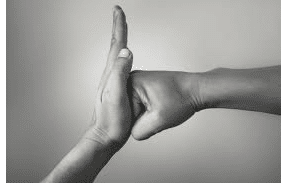Self-defense is a well-known defense to many. However, the factors used in the court to determine whether self-defense was properly used are less known. This blog post will review what criminal self-defense is and what constitutes the appropriate use of this defense.
What is Self-Defense?
Self-defense is a legal term to explain the use of physical force to protect oneself from harm. Self-defense can also be used as an excuse for committing a crime if it was used in response to another person’s attack or threat of attack. Self-defense takes its basis under section 34 of the Criminal Code of Canada (CC). This section states that “if a person has reasonable grounds to believe that force or a threat of force is being used against him or her or another person, that person can perform an act to defend himself, herself or the other person, as long as the act is reasonable under the circumstances”[1]. In other words, when looking at it from the perspective of the person claiming self-defence, the court will determine whether they truly were in danger and needed to use some sort of force in order to prevent harm from occurring.
Factors in determining Self-Defense?
When a person pleads self-defence during a trial, the judge will look at a number of factors to determine whether the act they committed constitutes self-defence. The factors outlined in section 34(2) of the CC that the courts can look at are:[2]
- The nature or force of threat the accused faced
- The court will look at what force the accused was facing. Was it a punch that was going to land on the accused’s face? Was someone pointing a gun at the accused? Or was someone holding a knife in a position to stab the accused?
- Whether the force was imminent and whether there were other means available to respond to the potential use of force
- The court will look at whether the accused could have walked away from the situation to avoid the force.
- If the accused was able to walk away from the situation to avoid the force, then the court would not allow them to claim self-defence. However, if the accused was facing a punch or the movement of a knife where their body was in danger and had no mode of escape, then the court would allow the claim of self-defence.
- The accused’s role in the incident
- The court can look at who committed a threat first. In other words, the court will look at the entire situation to see who escalated the situation to the point where a fight had to break out.
- Whether any party used or threatened to use a weapon
- If any weapons were used, the court would look at who pulled out a deadlier weapon. For example, if the accused pulled out a knife, but the other person pulled out a gun, the court would see that the other person had the deadlier weapon which would work more favourably for the accused to claim self-defence.
- The size, age, gender and physical capabilities of the parties
- When looking at this factor, the court would mainly look at who is more physically dominating in the situation.
- If the other person is more physically fit or bigger and launched an attack first, then this would work in favour of the accused to use self-defence. However, if the accused was more physically fit or bigger, it may not work out for them to claim self-defence.
- The nature, duration, history of the relationship between the parties
- The court will look at whether the accused had interacted with the other person in the past and whether they knew the other person used force in the past.
- This is beneficial for the accused because this is a reason for the accused to fear the other person. In other words, if the accused knew that the other person used force in the past, it enhances their chances of winning in court with a self-defence claim.
- The proportionality of the person’s response to the use of force
- This is a critical factor that a judge will strongly consider. The court will look at whether the accused used an excessive amount of force in response to the other person’s action and if so, it greatly decreases the accused’s chances of claiming self-defence.
- If the court sees that the accused used a disproportionate amount of force, they will less likely believe that they acted in self-defence and more likely believe that they acted in revenge.
- Whether the act was committed in response to force that the accused knew was lawful
- The court will look to see whether the accused used force in response to a force they knew was lawful to use.
- For example, if a police officer is arresting the accused based on reasonable grounds that they committed a crime and the accused applies force on them during the arrest, the accused cannot claim self-defence.
A Three-Part Test of Self-Defence
Section 34(1) of the CC outlines a three-part test that the accused can use to prove that their actions qualify as self-defence in addition to the above factors. The three-part test consists of:[3]
- Did the accused have a reasonable belief that force was being used or threatened to be used against them or another person?
- The key idea in this factor is not what the accused believed, but whether the belief of the accused that force was going to be inflicted upon them was rational. In other words, the belief that the accused was going to be attacked must be reasonable.
- Was the act that constituted the offence committed for the purpose of defending or protecting themselves or the other person?
- The idea here is whether the accused committed the act to protect himself/herself or another from harm, or was the act of the accused based on revenge.
- A good way to determine whether the accused committed the act for protection or for revenge is to see whether there was an opportunity for the accused to escape the harm about to be inflicted. If there was no opportunity for the accused to escape or run away from a potential attack, then it would more likely be considered an act of protection if the accused attacked back. However, if the accused had the opportunity to run away or escape a potential attack, but chose to attack back, then it would more likely be considered an act of revenge.
- Were the defendant’s actions reasonable under the circumstances?
- This factor uses an objective test. This is to determine whether the accused’s actions were reasonable. It must be aligned with how a reasonable person would act in the same circumstances.
Defence of Property
As we have discussed above, self-defence can be applied as a defence of the person. Either by defending yourself, or another individual. However, there is also the defence of property.
An accused can use the claim of defence of property when he or she needs to protect their property. Section 35 of the Criminal Code explains that someone is not guilty of an offence if they believe on reasonable grounds that another person[4]:
- Is entering, about to enter the property or already entered without consent or entitlement by law, or
- An accused can also use the claim of defence of property if someone is about to take the property, is doing so or has just done so and the accused is trying to obtain it back, or
- If the accused believes the property is about to be damaged or destroyed.
If the accused uses force on another person based on one or more of the situations described above, they can use the defence of property defence. The act committed by the accused must have been done to protect property from harm. However, unlike the defence of self-defence, the accused does not need to fear death or bodily harm in order to claim the defence of property.
To conclude,
It is important to know what self-defence entails and when it can be used. Self-defence is not an excuse for violence, but rather a means of protection in the face of imminent danger or threat. There are a number of requirements that must be met in order for self-defence to be considered justified. If you have been charged with an assault, it is important to know what constitutes self-defence and when you can use it. The defence of property also has different rules under the law depending on whether or not there was actual physical contact between your attacker and your property. If you are wondering whether your situation qualifies as self-defence, please contact us today and we’ll answer any questions you have about this topic.
Tailor Law Professional Corporation
2680 Matheson Blvd East, Suite 102,
Mississauga, ON, L4W 0A5

















